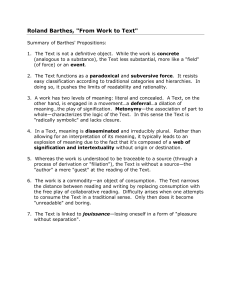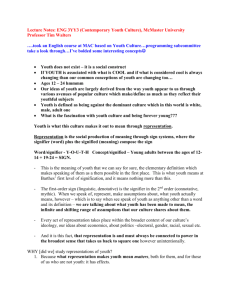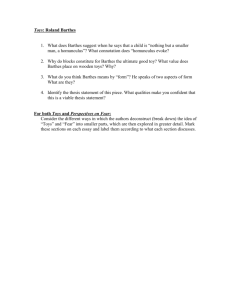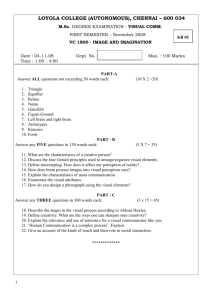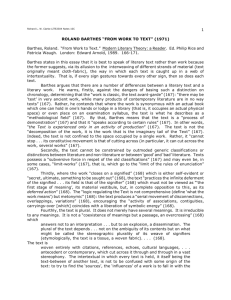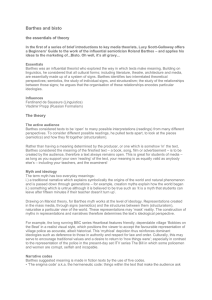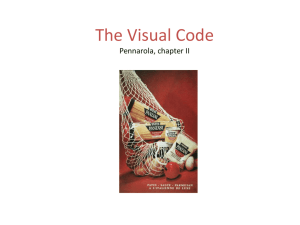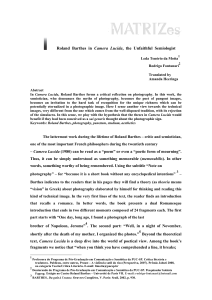Visual Communication and Meaning
advertisement
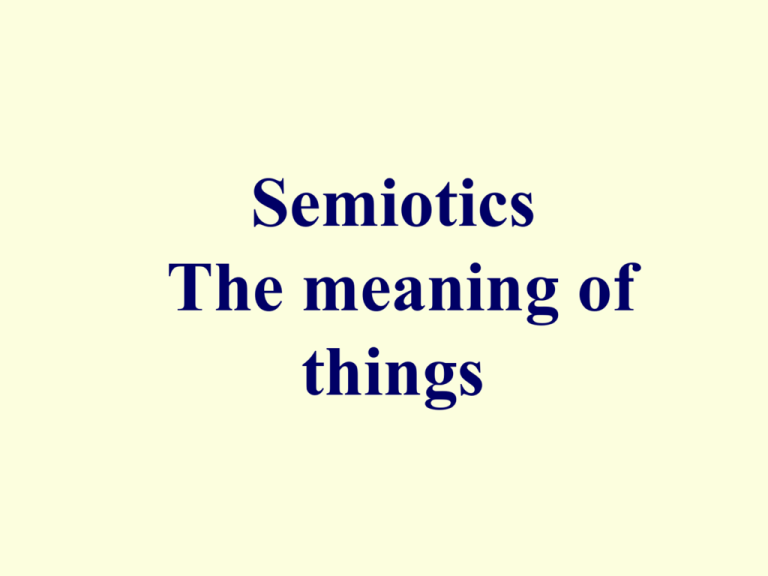
Semiotics The meaning of things CCS Hand In • Monday 7 April • 5.00pm Shelves outside GP20 CCS Office. Lower Floor Gray’s Portakabin Reading wk comm 18 Jan • Barthes, R. The new Citroen. • In: Barthes, R. Mythologies. Hill and Wang: New York; 1972, pp 88-90. Find on Web: • http://www.dsworldltd.com/new_citroen.html Bibliography - Barthes • Hall, S. Representation. London: Sage Publications Ltd; 1999, pp36-41 • Howells, R. Semiotics. In: Howells, R. Visual culture. Blackwell Publishers Ltd: Oxford; 2003, pp94-114. • Julier, G. The culture of design. Sage Publications Ltd. Oxford: Sage Publications Ltd; 2002, pp87-95 • Raizman, D. A history of modern design. Graphics and products since the industrial revolution. London: Laurence King Publishing Ltd; 2004 Web Resources • Dr Daniel Chandler. Introduction to semiotics for beginners. • See specifically: Introduction and Section 7 titled Denotation, Connotation and Myth. • http://www.aber.ac.uk/media/Documents/S4B/semiotic. html • Presentation by Professor John A Dowell, Michigan Stage University. Background and overview of Barthes’ life and work. • http://www.msu.edu/~jdowell/AL210/BarthesPresentati on.pdf • ‘Plastic’. Another essay from Mythologies analysing the contemporary and cultural value of ‘plastic’ as an emerging material in the 1950s • http://web.mac.com/kimowan/iWeb/portfolio/Studioblo g/E21717E3-8CC6-489A-A677-3AE148B77A2D.html Aim • To discuss meaning in design and culture • To introduce “semiotics” • To indicate that semiotics was more than a new method of cultural analysis but also signalled cultural change Art and design culture The 50s and 60s Jackson Pollock. One: Number 31. 1950. MOMA New York. Oil and enamel on canvas. Morris Louis. Number 99. 1959. Cleveland Museum of Art. Acrylic on canvas.251 x 360cm This is Tomorrow. Whitechapel Gallery London Independent Group 1956 Richard Hamilton. Just what is it that makes today’s homes so different, so appealing. 1956. Collage on paper. 26x24.8cm WARHOL, Andy Brillo Box 1964 Silkscreen ink on painted wood 17 1/8 x 17 1/8 x 14 in Marcello Nizzoli The Lettera 22. Olivetti. 1950 The Mirella Sewing Machine. 1956 Dieter Rams. The Transistor. Braun. 1956 Dieter Rams & Hans Gugelot SK4. “Snow White’s Coffin”. Braun. 1956 Modernism as an imposed solution “All believed that advances in science and technology were evidence of social progress and provided paradigms for design thinking. They thought that communication could be objective and that optimum solutions to design problems could be found. Many felt that design, if rationally conceived,. could help solve social problems and did not itself create such problems. And most assumed that goods should be mass produced by industry.” Victor Margolin. Design Discourse. 1998 1950S “Good Design” Edgar Kauffman Jnr. Dept of Industrial Design, MOMA “Kauffman did little more……. than reiterate the same Arts and Crafts values that had been voiced by so many Modern Movement spokesmen before him, emphasizing once again the well known tenets of truth to materials, the unification of form and function, aesthetic simplicity, and expression of the modern age…….. Jonathan Woodham 60s Pop: fun, disposability, colour pattern, vitality, kitsch. Clockwise from top left: Murdoch, Peter. ‘Spotty’ child’s chair. 1963 Archigram Magazine cover. 1967. De Pas, D’Urbino and Lomazzi. The ‘Blow’ chair. 1967 Pesce, Gaetano. ‘Up 2’ armchairs. 1969 Italian Radical Design Archizoom Associati, Naufragio di Rose dream bed. 1967 From high art and ‘good design’ to ‘things’ that communicate • Semiotics: something that stands for something else • Symbols: things ‘that represent or stand for something else’ (the swastika, the double mask of theatre…) • Signs? “Western culture has consistently privileged the spoken word as the highest form of intellectual practice and seen visual representations as second-rate illustrations of ideas” It is now being asserted that the way in which we understand society, and the place where we convey and create meaning, and establish attitudes, is essentially “visual” and not “textual” N. Mirzoeff. 1999 Making meaning Semiotics as one perspective The significance of Semiotics • treats objects, images and practices as “texts” to be read. • The question is not - What am I seeing ?, but - “What does it mean” ? It therefore, can cover; pictures, fashion, clothing, photographs, advertisements, furniture, household items, toys, films, cartoons, virtual imagery.... and treat them as “texts” to be read and decoded. Italo Calvino (1923-85) Invisible Cities. Cities and Signs 1 Rarely does the eye light on a thing, and then only when it has recognised that thing as the sign of another thing: a print in the sand indicates a tiger’s passage; a marsh announces a vein of water; the hibiscus flower, the end of winter…. The city of Tamara….the eye does not see things but images of things that mean other things: pincers point out the tooth drawers house; a tankard, the tavern….If a building has no signboard or figure, its very form and the position it occupies in the city’s order suffice to indicate its function: the palace, the prison ‘The embroidered headband stands for elegance; the gilded palanquin, power; the volumes of Averroes, learning; the ankle bracelet, voluptuousness. Your gaze scans the streets as if they were written pages; the city says everything you must think…’ Calvino THEORY From Linguistics to Semiotics • Ferdinand de Saussure. 1857 - 1913 • ‘Language is a shared system. It is only because we know and agree about the rules and codes, that we can communicate’ • The production of meaning is dependent on the “sign”. The Sign •The signifier + the signified = the sign. •The form + the idea in your head = the meaning But the relationship between the signifier and the signified is ARBITRARY, and dependent upon a shared code. It is this arbitrary relationship which permitted a linguistic theory to be applied to a wider cultural field C-A-T = The idea of the sign can be extended from the written or spoken word to images, objects, even activities and events in the everyday world. “Mythologies” 1957 Roland Barthes. (1915-80) Barthes extended Saussure’s concept of the sign to cultural objects, images and practices generally, treating these as components in a “language” which communicated and established meaning within society. ‘Every object in the world can pass from a closed, silent existence to an oral state, open to appropriation by society….’ Roland Barthes. From the essay ‘Myth Today’ in Mythologies. 1957 R. Barthes. Two levels of meaning SIGN – first level • Signifier – CAT, English the word made up of letters. It could as well be ‘chat’ or ‘gatto’… • Signified – image in your mind of a cat, any cat… • Sign – a cat ‘Barbie’ Toys always mean something ..literally prefigure the world of adult functions, prepare the child to accept them all…before he can even think about it…the alibi of a nature which has at all times created soldiers, postmen… Barthes. 1957 First level Denotation • Signifier: Barbie (word, toy, picture etc) • Signified: On the basis of the agreed “cultural code”, in the Western world, the word, toy or picture is understood to be, the Mattel doll Barbie. 2nd level Connotation Barbie as connotative ‘sign’ The perfect woman will be perfectly thin with elegant limbs and flawless skin. She will ‘possess’; beautiful clothing, jewellery, cars, racehorses, jacuzzi and jet ski in pink... She will never have enough stuff…. ….recently seen at Paris fashion week…perfect contemporary womanhood (See: Mary F Rogers. Barbie Culture. 2000) Myth and ‘naturalisation’ • ‘Toys here reveal the list of all the things the adult does not find so unusual, war, bureaucracy…’ • Deluxe Aggression Series Action Figure Star wars exclusive battlefront collection Spartan soldier.. At the level of connotation, the sign can tell the truth or lie, but it is connected to the wider social and cultural framework; to our values, our beliefs and our social systems Haim Steinbach Supremely black 1985 Wood formica Ceramic pitchers Cardboard detergent boxes 29 x 66 x 33 in All objects are "packaged" to deliver certain meanings. And desire packages everything. When we dress, we package ourselves, our bodies. Every thing and object has a skin through which it speaks. ….. We have feelings about these objects — we project into them, and communicate through them. …..In primitive societies, objects may be found on the ground, literally, strewn about the place as in a "natural" state. But in our advanced industrial Western society, objects are found on consoles, on tables, on countertops. These counters and tables are vehicles of presentation; they are objects, they have functions, but they also have skins, histories . . . Something happens when you put an object on one of those support structures. Haim Steinbach. Interview. Journal of Contemporary Art. http://www.jca-online.com/steinbach.html ‘The new Citroen’. In: Mythologies http://www.dsworldltd.com/new_citroen. html
